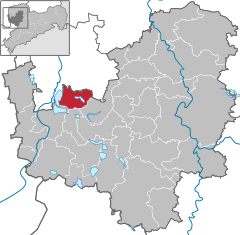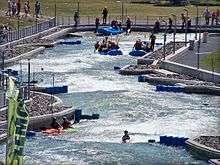Markkleeberg
| Markkleeberg | ||
|---|---|---|
 | ||
| ||
 Markkleeberg Location of Markkleeberg within Leipzig district   | ||
| Coordinates: 51°16′40″N 12°23′00″E / 51.27778°N 12.38333°ECoordinates: 51°16′40″N 12°23′00″E / 51.27778°N 12.38333°E | ||
| Country | Germany | |
| State | Saxony | |
| District | Leipzig | |
| Government | ||
| • Mayor | Karsten Schütze (SPD) | |
| Area | ||
| • Total | 31.36 km2 (12.11 sq mi) | |
| Elevation | 132 m (433 ft) | |
| Population (2017-12-31)[1] | ||
| • Total | 24,644 | |
| • Density | 790/km2 (2,000/sq mi) | |
| Time zone | CET/CEST (UTC+1/+2) | |
| Postal codes | 04416 | |
| Dialling codes | 0341, 034297, 034299 | |
| Vehicle registration | L | |
| Website | www.markkleeberg.de | |
Markkleeberg is a town in the Leipzig district, in the Free State of Saxony, Germany. It is on the river Pleiße, approximately 7 km south of Leipzig.
History
The town now called Markkleeberg has its origins in several towns that have been merged over the years. The center of modern-day Markkleeberg used to be called Oetzsch. It was merged with the smaller outlying district Markkleeberg in 1911 and renamed Oetzsch-Markkleeberg. Oetzsch-Markkleeberg was in turn merged with Gautzsch and the whole town was called "Markkleeberg", although Markkleeberg was the smallest, because it sounded most Germanic at a time of Nazi-led Germanisation.
The etymology of Markkleeberg may be 'clover hill market town '.
The name of Oetzsch has most likely a Wendish origin. In 1316 it was mentioned in a document as "Euschiz". The village originally had the form of a Rundling.
In 1813 much of the Battle of Leipzig took place where today's Markkleeberg is situated.
During 1944-1945, a forced labor camp for women was established in the town, initially a subcamp of the Ravensbrück concentration camp and later of Buchenwald. [2] Among the inmates were a thousand Jewish women from Hungary and 250 French resistance fighters.[3] In early April 1945 the surviving inmates were transferred to the Mauthausen-Gusen camp in Austria.
Today, Markkleeberg is a growing town, thanks to its proximity to Leipzig.[4]
Historical population
(Source since 1998: Statistical bureau of Saxony)
|
|
|
|
Culture
Markkleeberg is a well known tourist destination. Cospudener See and Markkleeberger See as well as a lot of parks and Kanupark Markkleeberg are close to the city.
 Markkleeberg town hall
Markkleeberg town hall Markkleeberg castle
Markkleeberg castle- agra-Park
 Ruined church in Wachau
Ruined church in Wachau
 Grunderzeit house in Markkleeberg
Grunderzeit house in Markkleeberg Luther church in Markkleeberg
Luther church in Markkleeberg
Twinned Towns
Markkleeberg is twinned with:





References
- ↑ "Aktuelle Einwohnerzahlen nach Gemeinden 2017] (Einwohnerzahlen auf Grundlage des Zensus 2011)" (PDF). Statistisches Landesamt des Freistaates Sachsen (in German). October 2018.
- ↑ Stessel, Zahava. "Memorial tablet for victims of the Women's Camp of Buchenwald" (in German). Retrieved 23 August 2018.
- ↑ "Homage to Frau Dr. Zahava Stessel, nee Katalin Szasz, survivor of the camp". www.markkleeberg.de/de/startseite/ Mark*Klee*Berg in Sachsen (in German). Retrieved 23 August 2018.
- ↑ "Life and Living in Markkleeberg". www.eigentumswohnung-kaufen-leipzig.de (in German). Retrieved 2017-11-23.
